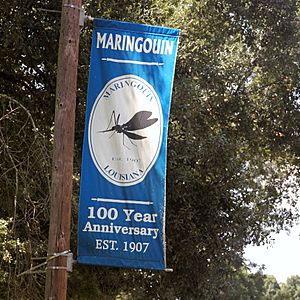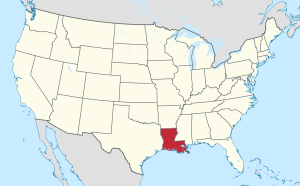Maringouin, Louisiana facts for kids
Quick facts for kids
Maringouin, Louisiana
|
|
|---|---|
|
Town
|
|

Centennial banner
|
|

Location of Maringouin in Iberville Parish, Louisiana
|
|

Location of Louisiana in the United States
|
|
| Country | United States |
| State | Louisiana |
| Parish | Iberville |
| Area | |
| • Total | 0.74 sq mi (1.91 km2) |
| • Land | 0.74 sq mi (1.91 km2) |
| • Water | 0.00 sq mi (0.00 km2) |
| Elevation | 20 ft (6 m) |
| Population
(2020)
|
|
| • Total | 891 |
| • Density | 1,207.32/sq mi (466.01/km2) |
| Time zone | UTC-6 (CST) |
| • Summer (DST) | UTC-5 (CDT) |
| Area code(s) | 225 |
| FIPS code | 22-48610 |
Maringouin is a small town located in Iberville Parish, Louisiana, in the United States. It is part of the larger Baton Rouge metropolitan area. In 2020, about 891 people lived there.
Contents
What's in a Name? The Meaning of Maringouin
The name "Maringouin" comes from Louisiana Creole, a language spoken in Louisiana. It means "mosquito." You say the name like mah-ring-gwin.
Exploring Maringouin's Geography
Maringouin is in the northern part of Iberville Parish. Its northern edge touches the Pointe Coupee Parish line. To the east, you'll find Bayou Grosse Tete.
Louisiana Highway 77 runs through the middle of town. This highway goes north about 5 miles (8 km) to Livonia. It also goes southeast about 6 miles (10 km) along Bayou Grosse Tete to Rosedale. Another road, Louisiana Highway 76, goes south from Maringouin for about 7 miles (11 km) to Interstate 10 at Ramah.
The town covers about 0.74 square miles (1.9 square kilometers) of land. Maringouin is also part of the Acadiana region of Louisiana, where many people speak French.
Understanding Maringouin's Population
The population of Maringouin has changed over the years. Here's a look at how many people have lived there during different census counts:
| Historical population | |||
|---|---|---|---|
| Census | Pop. | %± | |
| 1910 | 447 | — | |
| 1920 | 399 | −10.7% | |
| 1930 | 518 | 29.8% | |
| 1940 | 708 | 36.7% | |
| 1950 | 898 | 26.8% | |
| 1960 | 1,168 | 30.1% | |
| 1970 | 1,365 | 16.9% | |
| 1980 | 1,291 | −5.4% | |
| 1990 | 1,149 | −11.0% | |
| 2000 | 1,262 | 9.8% | |
| 2010 | 1,098 | −13.0% | |
| 2020 | 891 | −18.9% | |
| U.S. Decennial Census | |||
Who Lives in Maringouin?
In 2020, there were 891 people living in Maringouin. These people lived in 393 households, which are like homes or families living together. About 248 of these were families.
Here's a breakdown of the different groups of people living in Maringouin in 2020:
| Group | Number | Percentage |
|---|---|---|
| White (not Hispanic) | 105 | 11.78% |
| Black or African American (not Hispanic) | 770 | 86.42% |
| Native American | 1 | 0.11% |
| Other/Mixed | 10 | 1.12% |
| Hispanic or Latino | 5 | 0.56% |
In 2000, there were 1,262 people living in Maringouin. The town had 421 households. About 40.4% of these households had children under 18 living there. The average household had 3 people, and the average family had 3.43 people.
The median age in Maringouin in 2000 was 32 years old. This means half the people were younger than 32 and half were older. About 33.1% of the population was under 18 years old.
Maringouin's Historical Connection
Maringouin has a historical link to an important event from 1838. At that time, a group called the Society of Jesus (also known as the Jesuits) in Maryland decided to sell 272 people they enslaved. Many of the descendants of these enslaved people now live in and around Maringouin.
One of the schools connected to the Jesuits, Georgetown University, later studied this sale. They decided to offer the descendants of these enslaved people special consideration when applying to the university. This means they would be given the same attention as other members of the Georgetown community during the admissions process.
Notable People from Maringouin
- Rick Ward III: He has served as a state senator for District 17 since 2012.
See also
 In Spanish: Maringouin para niños
In Spanish: Maringouin para niños

